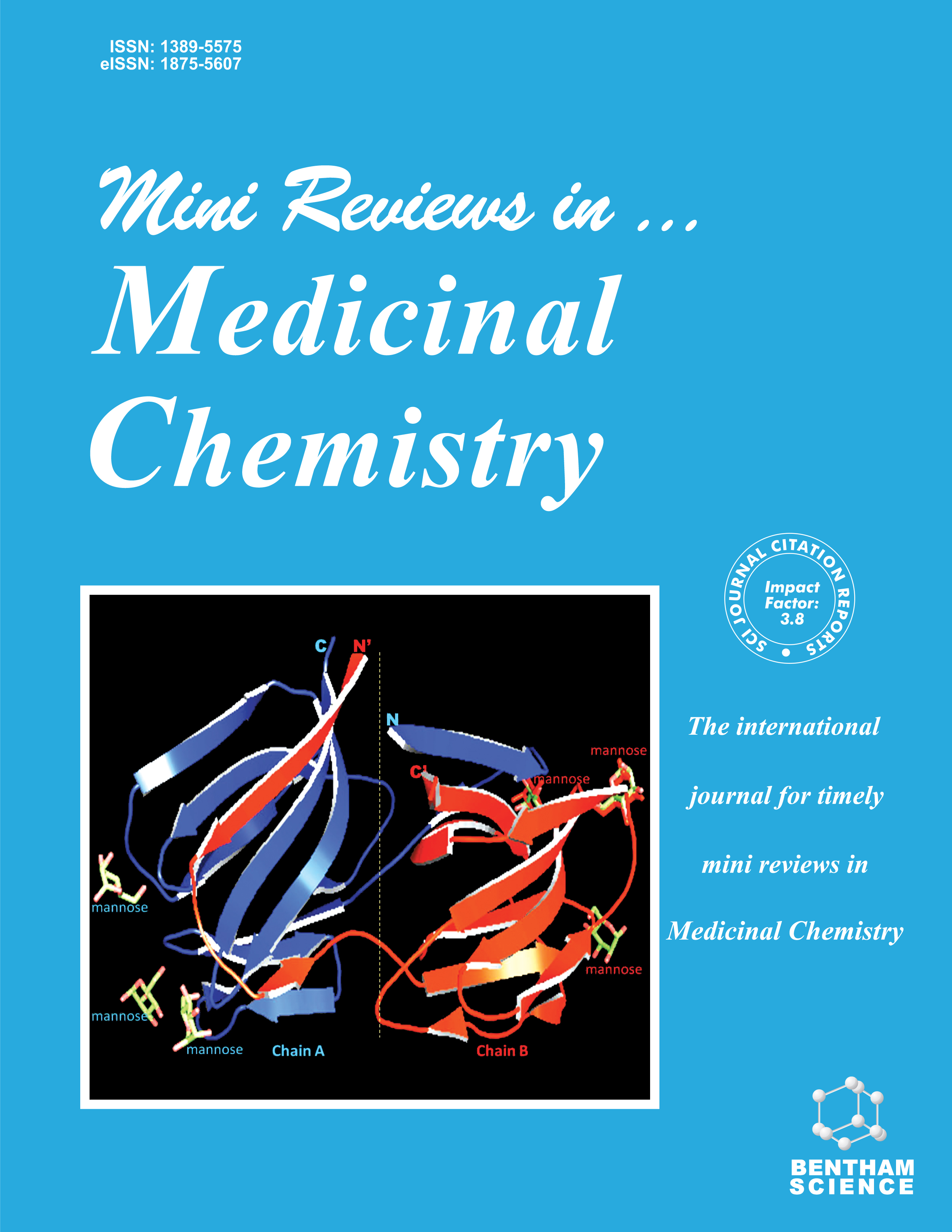- Home
- A-Z Publications
- Mini Reviews in Medicinal Chemistry
- Previous Issues
- Volume 7, Issue 3, 2007
Mini Reviews in Medicinal Chemistry - Volume 7, Issue 3, 2007
Volume 7, Issue 3, 2007
-
-
Somatostatin sst4 Ligands: Chemistry and Pharmacology
More LessAuthors: A. Michael Crider and Ken A. WittSeveral classes of compounds (thioureas, ureas, β-glucosides, sulfonamides, and cyclic peptides) show enhanced binding affinity and selectivity at somatostatin subtype 4 receptors (sst4). Pharmacophore models have recently been proposed to explain receptor subtype selectivity. The chemistry and therapeutic potential of sst4 ligands will be the subject of this review.
-
-
-
Recent Advances in the Development of Hybrid Molecules/Designed Multiple Compounds with Antiamnesic Properties
More LessNovel compounds have been developed that (in many cases) inhibit cholinesterases and concomitantly interact with at least one further pharmacological target, such as 5-HT3 or H3 receptors. But also enzymes like monoamine oxidase and the serotonin transporter have been targeted. Hybrid molecules can also incorporate antioxidant or neuronal Ca2+- channel-blocking structures.
-
-
-
Radioactive Drugs in Drug Development Research: Quality Assurance Issues
More LessIncreasing number of new drugs, drug formulations and drug delivery systems is evaluated using noninvasive imaging methods. A successful use of new drugs and radiopharmaceuticals depends on their proven quality. This review provides a brief outline of the quality control procedures required for radiolabeled drugs within the context of the existing regulations.
-
-
-
G-Coupled Protein Receptors and Breast Cancer Progression: Potential Drug Targets
More LessBreast cancer remains a leading cause of death despite early screening and advances in medicine. Bone marrow metastasis often complicates the clinical picture by requiring more aggressive treatment and worsening long-term prognoses. Recent therapeutic targeting of hormonal receptors such as human epidermal growth factor receptor 2 and estrogen receptor has shown limited success in treating localized disease for th Read More
-
-
-
CD26/Dipeptidyl Peptidase IV as a Novel Therapeutic Target for Cancer and Immune Disorders
More LessAuthors: Michael A. Thompson, Kei Ohnuma, Masako Abe, Chikao Morimoto and Nam H. DangCD26 is a 110 kDa surface glycoprotein with intrinsic dipeptidyl peptidase IV (DPPIV) activity that is expressed on numerous cell types and has a multitude of biological functions. An important aspect of CD26 biology is its peptidase activity and its functional and physical association with molecules with key roles in various cellular pathways and biological programs. CD26 role in immune regulation has been extensively cha Read More
-
-
-
Antivirals of Ethnomedicinal Origin: Structure-activity Relationship and Scope
More LessAuthors: Debprasad Chattopadhyay and Trailokya N. NaikEthnomedicinal plants have been used as source of candidate drugs for almost all diseases, but the number of compounds having antiviral activity is scarce. Irrespective of type of viruses and the cells they infect, there are a very few specific viral targets for the natural molecules to interact. Most of the available antiviral drugs often lead to the development of viral resistance coupled with the problem of side effects, recurren Read More
-
-
-
Boronated DNA-Binding Compounds as Potential Agents for Boron Neutron Capture Therapy
More LessAuthors: Ellen L. Crossley, Erin J. Ziolkowski, Jeffrey A. Coderre and Louis M. RendinaBoron Neutron Capture Therapy (BNCT) is a binary cancer treatment that exploits the short range particles released from a nuclear fission reaction involving the non-radioactive 10B nucleus and low-energy (thermal) neutrons for the destruction of tumour cells. If boronated agents are targeted towards chromosomal DNA, the efficiency of BNCT is greatly enhanced. This article presents a concise review of DNA-binding compound Read More
-
-
-
Antioxidants Derived from Vitamin E: An Overview
More LessAuthors: H. Cerecetto and G. V. Lopezα-tocopherol is a very well-known potent antioxidant and radical scavenger in chemical and biological systems. Its structure has served as starting point for design and synthesis of more potent antioxidant analogues with regard to its potential clinical and nutritional applications in human health. Furthermore, in recent years, intense research has been made not only in the development of hybrid compounds with classical drug moi Read More
-
-
-
Raxofelast, (±)5-(Acetyloxy)-2,3-dihydro-4,6,7-trimethyl-2-benzofuranacetic Acid: A New Antioxidant to Modulate the Inflammatory Response During Ischemia-Reperfusion Injury and Impaired Wound Healing
More LessAuthors: A. Bitto, L. Minutoli, F. Squadrito, F. Polito and D. AltavillaRaxofelast, also named IRFI 016 or (±)5-(Acetyloxy)-2,3-dihydro-4,6,7-trimethyl-2-benzofuranacetic acid, belongs to a family of novel molecules designed with the aim to maximize antioxidant potency of phenols related to Vitamin E ( α-tocopherol). This review will focus on the antioxidant and radical scavenging activity of this new promising compound.
-
Volumes & issues
-
Volume 25 (2025)
-
Volume 24 (2024)
-
Volume 23 (2023)
-
Volume 22 (2022)
-
Volume 21 (2021)
-
Volume 20 (2020)
-
Volume 19 (2019)
-
Volume 18 (2018)
-
Volume 17 (2017)
-
Volume 16 (2016)
-
Volume 15 (2015)
-
Volume 14 (2014)
-
Volume 13 (2013)
-
Volume 12 (2012)
-
Volume 11 (2011)
-
Volume 10 (2010)
-
Volume 9 (2009)
-
Volume 8 (2008)
-
Volume 7 (2007)
-
Volume 6 (2006)
-
Volume 5 (2005)
-
Volume 4 (2004)
-
Volume 3 (2003)
-
Volume 2 (2002)
-
Volume 1 (2001)
Most Read This Month
Article
content/journals/mrmc
Journal
10
5
false
en


